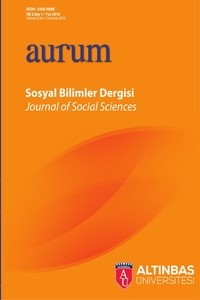TEZGÂH: BEDEN FARKINDALIĞI YARATAN BIR ÇALIŞMA MASASI TASARIMI
Bu yazıda Texas Üniversitesi Sanat Tarihi bölümünde tamamladığım doktora eğitimim sırasında kendi kullanımımiçin tasarladığım çalışma masasının Türkiye’ye döndükten sonra yeniden ürettiğim versiyonunu tanıtacağım.Bu çalışmanın amacı feminen bir çalışma masası türü olan mutfak “tezgâh”ını bir makina sistemi olanbilgisayara adapte ederek uzun saatler boyunca yazı yazmak zorunda olan bir çalışanın bedensel farkındalığınıartıracak ve psikolojik ihtiyaçlarına cevap veren bir ürün ortaya çıkarmaktı. Bu nedenle bir dizüstü bilgisayarlamasaüstü bir diğer bilgisayarın ekran ve klavyesi kombine edilerek üç seviyeli bir düzenek kurgulanmıştır.Tezgâh kavramının feminen vurgusu masanın kompozisyonun birim elemanın Osmanlı camilerininrestorasyonu amaçlı üretilmiş İznik çinilerinden oluşturulmasıyla korunmuştur. Görsel iletişim alanında en sonüretilmiş literatür dayanarak İznik çinilerinin oluşturduğu dekoratif arka planın görme ve dokunma duyularınahitap ederek hem zihni uyarıcı hem de sakinleştirici bir psikolojik etki uyandıracağı iddia edilmektedir.
Anahtar Kelimeler:
Çalışma masası, Mutfak tezgahı, Ergonomi
Counter: Design of a Body Conscious Study Desk
This paper presents the study desk I re-designed in Turkey from the prototype I produced for my own useduring my doctoral education in the Department of Art and Art History at the University of Texas, Austin. Thepurpose of this design was to accommodate the bodily and psychological needs of a writer by integratinga feminine form of study desk “kitchen counter” with a machine system, a computer. To this end, a three-layeredsystem was built to accommodate a laptop computer in combination with the screen and keyboardof a desktop. The compositional unit of the desk, consisting of İznik tiles originally produced for the restorationof the Ottoman mosques in Istanbul, preserved feminine quality of the kitchen counter. Building onthe recent literature on visual communication, I argue that the decorative background consisting of İznik tilesappeals to both visual and tactile senses; stimulates and calms the mind.
Keywords:
Study Desk, Kitchen counter, Ergonomi,
___
- Aarås, A., G. Horgen,ve H.H. Bjorset, “Musculoskeletal, visual and psychosocial stress in VDU operators before and after multidisiplinary ergonomic interventions. A 6 years prospective study part II.” Appl Ergon 32 (2001): 559-571.
- Ekman, A. A Andersson ve M. Hagberg, “Gender differences in muscoskeletal health of computer and Mouse users in the Swedish workforce.” Occupational Medicine (Lond) 50 (2000): 608-13.
- Pallasmaa, Juhani, The Eyes of the Skin: Architecture and the Senses. Wiley, 2012.
- Panero, Julius ve Martin Zelnik, “Human Dimension & Interior Space. A Source Book of Design Reference Standards,” Whitney Library of Design. The Architectural Press, London, 1979.
- Punnett, L. ve U. Bergqvist, Visual display unit work and upper extremity muscoskeletal disorders. Stockholm: National Institute for Working Life, 1997.
- Schlote, T., G. Kadner, N. Freudenthaler, “Marked reduction and distinct patterns of eye blinking in patients with moderately dry eyes during video display terminal use.” Graefes Arch Clin Exp Ophtalmol 2004; Apr; 242(4): 306-12.
- Schlör, Joachim, Nights in the Big City, Paris, Berlin, London 1840-1930. Reaktion, 1998.
- Wahlström, Jens, “Ergonomics, muscucoskeletal disorders and computer work,” Occupational Medicine 55 (2005): 168-176.
- ISSN: 2458-9896
- Yayın Aralığı: Yılda 2 Sayı
- Başlangıç: 2016
- Yayıncı: Altınbaş Üniversitesi
